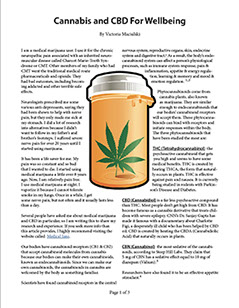
My Take On...
Cannabis and CBD For Wellbeing
By Victoria Maciulski, May 2018
I am a user of medical marijuana. I use it for the chronic neuropathic pain associated with an inherited neuromuscular disease called Charcot-Marie-Tooth Syndrome or CMT. Other members of my family who had CMT went the traditional medical route — pharmaceuticals and opioids. They had bad outcomes, including becoming addicted and other terrible side effects.
Neurologists prescribed me some various anti-depressants, saying they had been shown to help with nerve pain, but they only made me sick at my stomach. I did a lot of research into alternatives because I didn’t want to follow in my father's and brother's footsteps. I suffered severe nerve pain for over 20 years until I started using marijuana.
It has been a life saver for me. My pain was so constant and so bad that I wanted to die. I started using medical marijuana a little over 8 years ago. Now, I am relatively pain free. I use medical marijuana at night. I vaporize it because I cannot tolerate smoke in my lungs. Once in a while, I get some nerve pain, but not often and it usually lasts less than a day.
Several people have asked me about medical marijuana and CBD in particular, so I am writing this to share my research and experience. If you seek more info than this article provides, I highly recommend visiting the website called Medical Jane.
Our bodies have cannabinoid receptors (CB1 & CB2) that accept cannabinoid molecules from cannabis because our bodies can make their own cannabinoids, known as endocannabinoids. Since we can make our own cannabinoids, the cannabinoids in cannabis are welcomed by the body as something familiar.
Scientists have found cannabinoid receptors in the central nervous system, reproductive organs, skin, endocrine system and digestive tract. (1) As a result, the body's endocannabinoid system can affect a person's physiological processes, such as immune system response, pain & inflammation, appetite & energy regulation, learning & memory and mood & emotion regulation. (1),(2)
Phytocannabinoids come from cannabis plants, also known as marijuana. They are similar enough to endocannabinoids that our bodies' cannabinoid receptors will accept them. These phytocannabinoids can bind with receptors and initiate responses within the body.
The three phytocannabinoids that have been studied the most are:
THC (Tetrahydrocannabinol) — the psychoactive cannabinoid that gets you high and seems to have some medical benefits. THC is created by heating THCA, the form that naturally occurs in plants. THC is effective against pain and nausea. It is currently being studied in rodents with Parkinson's Disease and Diabetes.
CBD (Cannabidiol) — is a far less psychoactive compound than THC. Most people don’t get high from CBD. It has become famous as a cannabis derivative that treats children with severe epilepsy. CNN's Dr. Sanjay Gupta has made it famous with a documentary about Charlotte Figi, a desperately ill child who has been helped by CBD oil. CBD is created by heating the CBDA (Cannabidiolic Acid) that naturally occurs in plants.
CBN (Cannabinol) — the most sedative of the cannabinoids, according to Steep Hill Labs. They claim that 5 mg of CBN has a sedative effect equal to 10 mg of diazepam (Valium).(3)
Researchers have also found it to be an effective appetite stimulant.(4)
CBD BASICS
CBD is an acronym for "Cannabidiol" which is one of over 100 "phytocannabinoids" (chemical compounds) that have been isolated from cannabis (aka marijuana) plants. CBD has been found in the stalks, seeds and flowers of cannabis plants, including marijuana and hemp.
CBD is currently being studied as a treatment for alcoholism, antibiotic resistant infections, anxiety, arthritis, chronic pain, diabetes, depression, inflammation, psychosis and even cancer.(5)
CBD has been shown to have neuro-protective and neurogenic effects and is safe even at high doses.(5)
Clinical trials have been performed on people with epilepsy.(6)
According to Dr. Axe, there are 8 PROVEN benefits of CBD.(See link to Dr. Axe article in item 7 of links at bottom of this article.)
1. Pain relief and inflammation reduction. People with neuropathic pain and MS have been successfully treated with CBD combined with some THC.
2. Antipsychotic effects similar to those of pharmaceuticals but with a safer profile.
3. Reduces anxiety, panic disorder and obsessive-compulsive disorder.
4. Inhibits cancer cell migration, adhesion and invasion. Also has been shown to kill several different types of breast cancer cells.
5. Reduces nausea. Cannabis has been used to combat nausea in chemotherapy patients for years.
6. Treating seizures. (6)
7. Lowers incidence of diabetes.(7)
8. Promotes cardiovascular health.(7)
I personally know people who use CBD products for menstrual cramps, fibromyalgia and small cell neuropathy.
HIGH CBD STRAINS
There are several cannabis strains known to be higher than average in THC. They include:
ACDC
CannaTonic
Canna-Tsu
Harlequin
Harle-Tsu
R-9 (aka Charlotte’s Web)
Ringo's Gift
Sour Tsunami
Stephen Hawking Kush
Sweet and Sour Widow
White Widow
You can look up more information on these strains at Leafly.com. If you’re buying from a dispensary, I recommend that you get product that has been tested for CBD content to make sure there really is sufficient CBD content and tested for pesticides. Ingesting pesticides can create a myriad of new health issues.
CBD PRODUCTS
There is a brand of CBD Oil called CBD Pure (http://www.cbdpure.com/) that is derived from organically grown hemp that has been lab tested and certified. They will ship via mail order. I will continue to research CBD products and update this info as I find more CBD products that are high in CBD and free of pesticides, chemicals and contaminants.
MORE RESEARCH NEEDED
Extensive research into medical uses for cannabis is being done in Israel. Research into medical uses for cannabis has been limited in the United States, due to it being classified as a Schedule I drug. That classification declares that cannabis is dangerous and there is no medical value, even though neither is true. It was and remains a purely political classification.
There are moves being made in Congress, albeit slowly, to remove cannabis from Schedule I. Some bills would move it to Schedule II or III. Other bills would decriminalize it entirely nation wide.
There are over 60 health and government organizations that advocate for legalization and research into cannabis medical uses.(8) cannabis and it’s derivatives have continued to gain mainstream support.
With full legalization coming in Canada this year and talk of legalization in Mexico, it may help further legalization efforts in the U.S.
References (Click on names below to read reference material):
(3) Steep Hill Labs
(5) Project CBD
(7) Dr Axe
(8) NORML
© Copyright 2013 - 2018 by Pat Hennessy MD MPH Design by Victoria Young Maciulski
